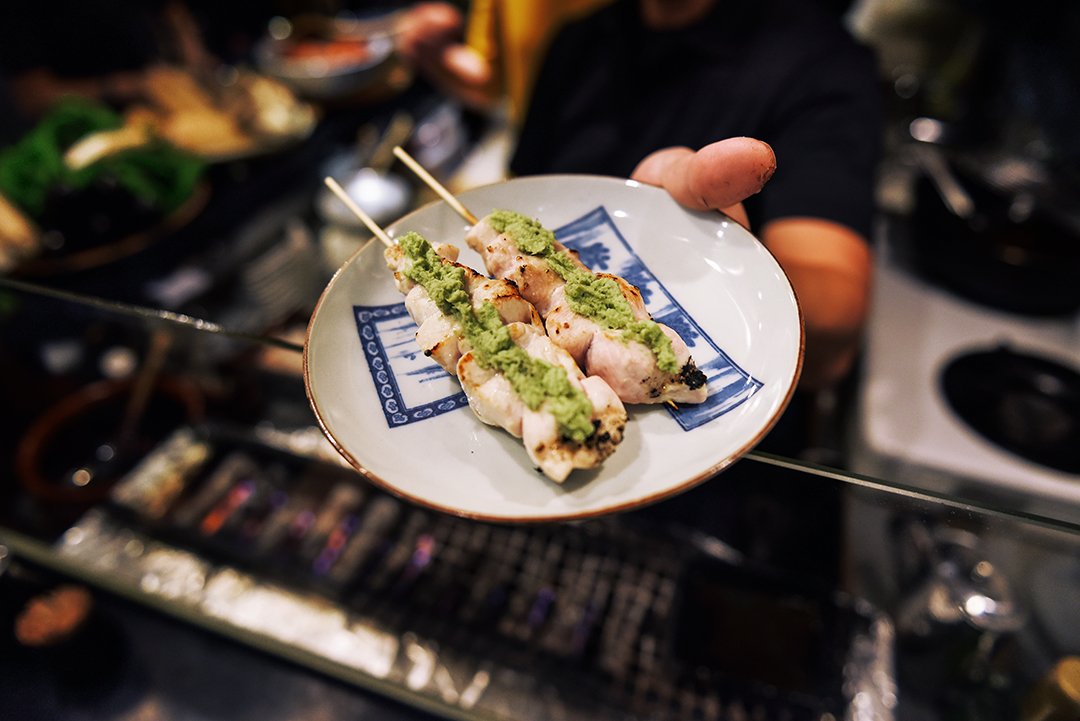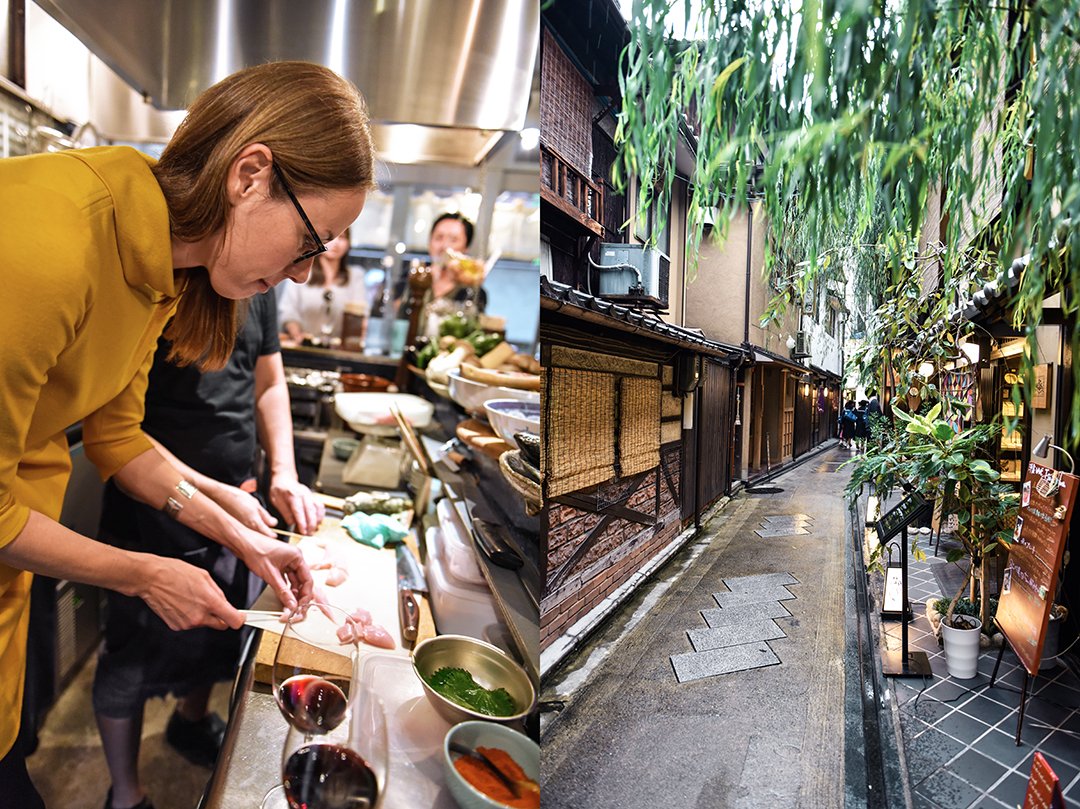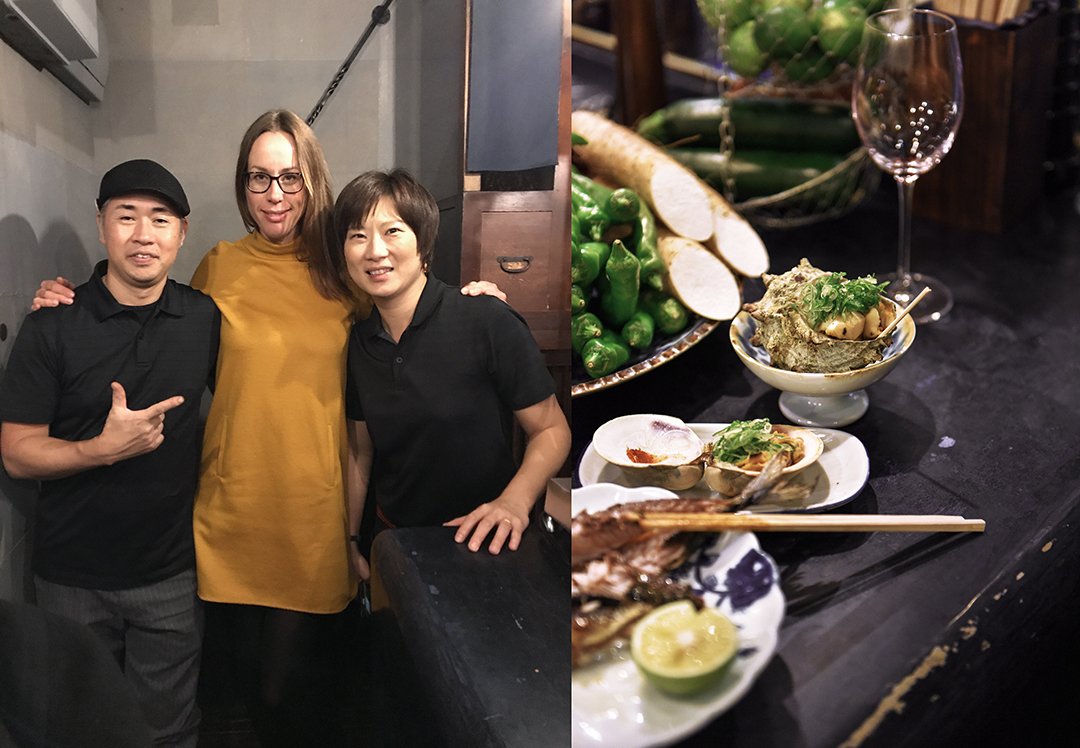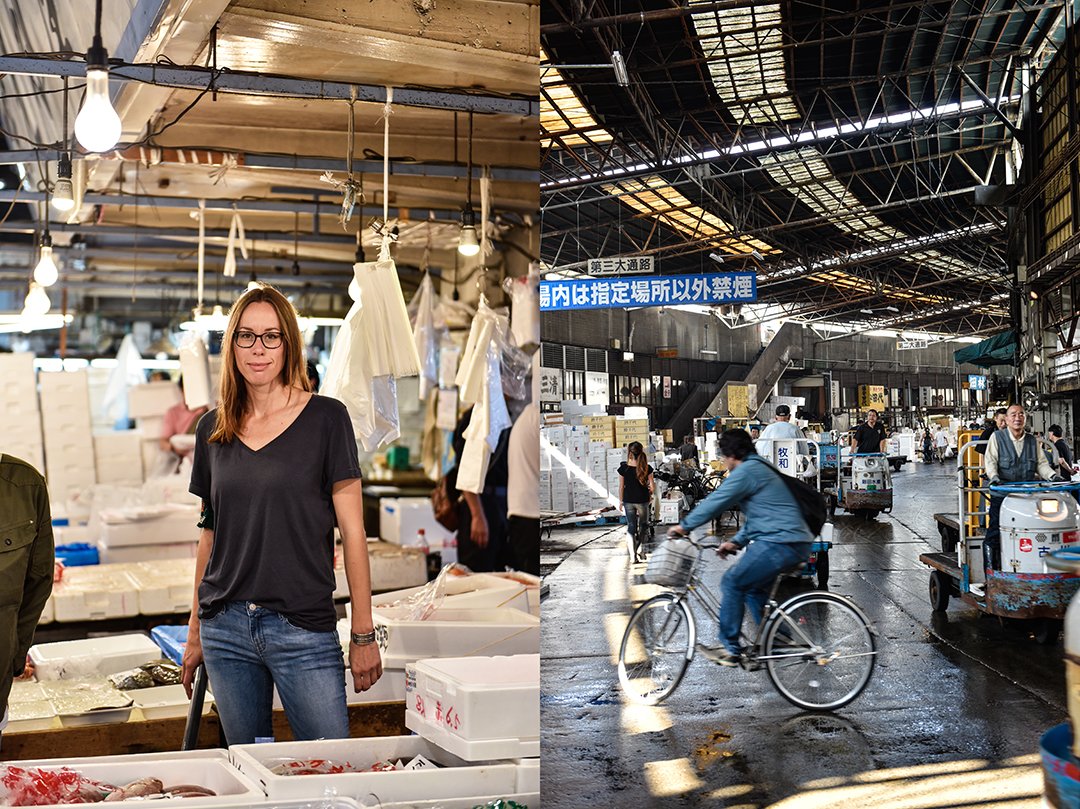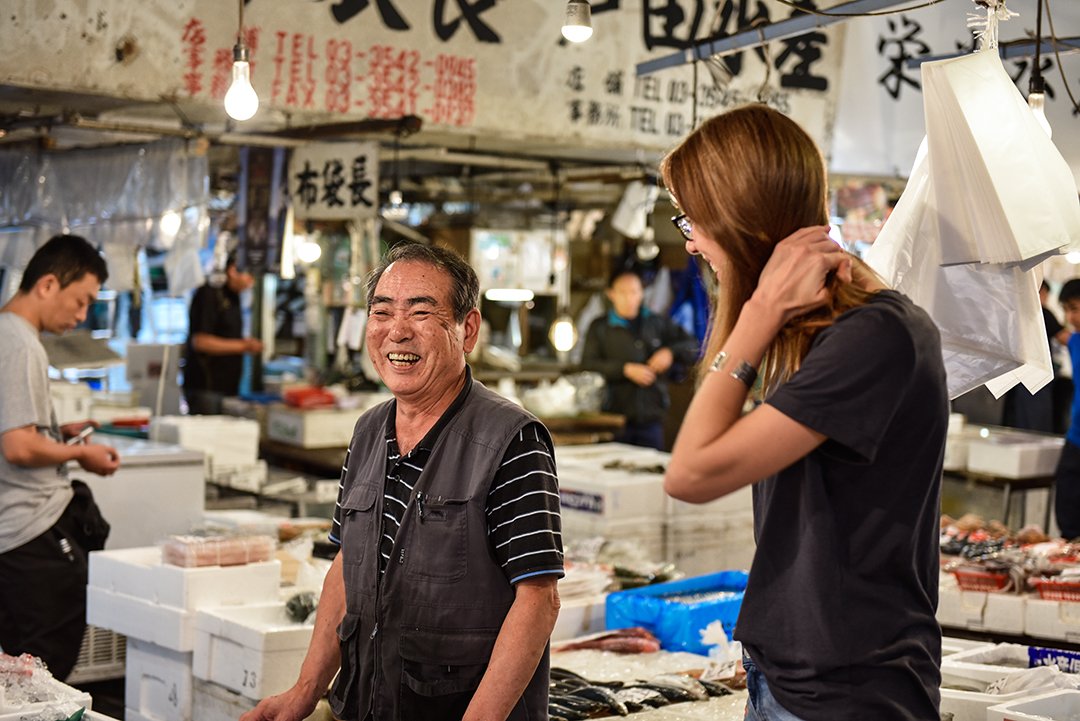Meet In Your Kitchen | Taka's Japanese-Italian Fusion Cuisine in Kyoto
Eating at Taka's restaurant in Kyoto feels like having a Japanese feast celebrated with your exuberant Italian family. The place is tiny, it's in a narrow old house tucked into a small secluded alley right in the old city's busy heart. An L-shaped counter separates the celebrated chef from his hungry guests, however, there's a lot of interaction going on. The kitchen is open so you can follow all of Chef Nishimura Takashi's steps, how he grinds the fresh wasabi in smooth circles on a shark skin-covered wooden board (the only proper way to grind the green root as I've learned). The charming chef looks like a versed dancer. He quickly grabs pots and spices from the shelves behind him and then, in the next second, turns around to briefly cook tender chicken sashimi (see the recipe below) in the flames of his little grill; or local beef, or mackerel until it has a crispy golden crust all around. The restaurant's menu is a revelation, sea urchin spinach and tempura lotus root sprinkled with matcha salt are simply divine. Sitting at the counter and enjoying Japanese tapas is a feast in its true meaning: You eat, drink, and share delicious treats with old and new friends.
Kyoto born Chef Taka has lived and worked abroad for years, in Australia, Denmark, and in Italy, in Milan, where he also met his wife Akane. Before they opened their gastro pub in Kyoto, Taka worked at Armani's Nobu Milano restaurant for 10 years, which explains why you can also find wonderful organic Tuscan wines and Mediterranean style dishes on the menu, like the fruitiest eggplant slowly cooked in an aromatic tomato sauce. It's the combination of these two worlds that makes the couple's restaurant in Kyoto so exciting, yet at the same time it's so relaxed. It's the kind of place where you end up chatting with the guests sitting next to you, exchanging stories and dishes, saying Kanpai (cheers) with a glass of red wine in your hand or ending the night with an extensive sake tasting involving everyone in the room.
Taka and Akane love food and people, the people who visit them, their guests, and the people they work with, their kitchen team, but also the suppliers who deliver fresh produce and products of the best quality to this tiny kitchen in the heart of Kyoto. The couple knows all of them personally, they've been working with them for years, most of them coming from the area. Having lived and worked in two food meccas in the world, Italy and Japan, the restaurateurs say that they can only create fantastic food, if the ingredients are perfect, vegetables picked at the peak of their season, the meat coming from animals that were bred and fed with care and respect. Japanese and Italian cooking is similar, both cuisines are very simple and focus on good ingredients, and at Taka, they create a very complete fusion.
In the next months, I’ll share many Meet In Your Kitchen features with you that took me to California, Italy, France, and Japan. Thanks to Zwilling for sponsoring these features for our culinary trip around the world!
Grilled Chicken Sashimi with Wasabi
By Taka Nishimura
Chef Taka uses chicken of outstanding quality, he knows the farmer and he can guarantee the meat's quality and freshness, which is why he can serve this dish almost raw. However, it is highly recommended to cook chicken until it's cooked through.
Serves 2
4 skinless, boneless chicken breast tenderloins, sashimi grade
Freshly grated wasabi
Rock salt
4 wooden skewers
Heat the BBQ.
Cut each chicken tenderloin into 6 pieces and thread onto the 4 skewers. Grill lightly until just done.
Spread the chicken with freshly grated (!) wasabi and season with salt to taste. Serve immediately.
Could you introduce yourself?
My name is Nishimura Takashi. I lived in Italy for a long time, about 15 years. I worked in a world-renowned restaurant called NOBU. And about 2 years ago I moved back to Kyoto, my hometown, to open this small restaurant.
What is your most cherished childhood memory connected to the kitchen?
A cherished memory would have to be, when I was a child, all I watched were shows about food on TV. All I watched were cooking TV shows, and I remember cooking a lot with my siblings when we were small. No one in my family is a cook, I'm the only one who followed a career as a chef. And it was when I was in primary school that I decided to become a chef, it was then that I decided to learn how to cook Japanese cuisine.
Why did you decide to move to Italy and work in Italy as a chef?
Well, I had always made Kaiseki cuisine in Kyoto, I trained in Kyoto Kaiseki for about 15 years. And so then, at that time, Kyoto was amazing, it was a narrow entrance into Japanese cuisine. Now foreigners come here to learn how to cook Kaiseki, but it wasn't like that at all back then. So I wondered why? Japanese people go to Italy to study Italian cuisine, and to France to study French cuisine. So I thought, why don't foreigners come to Japan to study Japanese cuisine? I figured that if that was the case than I wanted to go abroad to teach Japanese cuisine, that's what I felt I wanted to do. And I remember feeling that I'd been a chef for 10 years, I'd learnt a lot in that time and wanted to share my knowledge abroad. So I chose somewhere that had similar food. I first chose Italy because I thought they had a simple way of cooking, and ingredients that had a lot of umami, where Japanese cuisine would be accepted by Italian tastes. And then I worked at NOBU in Italy.Now, in the last 10 years, things changed. Many chefs come to Kyoto and Osaka, Tokyo, studying the Japanese style.
What changed over the years?
That was probably because Japanese chefs became more open-minded. I think one reason is that they began to look outside Japan more. Also, famous chefs wanted to learn more about the mentality behind Japanese Kaiseki cuisine and how to make it. Making each course and slowly serving one small plate after another is Japanese Kaiseki's style. That's how you draw people to your restaurant. You're delicate even when you serve the food, there is even a special orientation for each plate.Every country's cuisine is wonderful, but in Japan it's all about the cut. For example, how sashimi is cut, how the vegetables are cut, how the meat is cut. These cuts create an excellent style of cooking, it's Japanese cooking. It's "katsuru" which means "cuts", which is what gives it such a high aesthetic. Even with sashimi the chefs cut them beautifully. It creates a very unique Japanese aesthetic. The kitchen knife cuts amazingly, every day you need to sharpen your knives, and sharpening them is one part of a chef's training, and I think even foreigners now sense this beauty. That's what I think. Vegetables cut straight, how they're beautifully peeled into hexagons, all kinds of shapes, the manual work that goes into it is amazing.
What makes a good knife? What are the important features of a good knife?
Of course how it cuts, the better it cuts the more beautiful the cut is. Also, how it feels when you hold it. You might have the same knife, but their weights can be different. Or there are knives that suit only you, so Japanese chefs will always buy their own knives. There's also a balance to them. And chefs are using them for a long time, for the entire day, so it needs to not get worn out, it needs to not be a burden for chefs that work for a long time. I think all of these things are considered when knives are made, there's a long history for this. Japanese knives are very particular. Fish is fish, vegetables are vegetables, meat is meat, and we divide them as such, but I think a knife that can be used for all of these is amazing.
What is special about Kyoto cuisine compared to other parts of this country?
I'd say how we compose the meal. There are a lot of difficult things about it but the best thing is how you can enjoy it as you like. Next is how the plates match. There are a number of Japanese meals where you look at the plates as you eat, and there are lots of regions that can make great plates. There's also the matter of gathering good ingredients. Of course each region of Japan has its own wonderful ingredients, but among those, you have Kyoto chefs who will search all over the place to find the best ingredients of the season and who will think of their customers’ faces as they make them. That mentality is unbroken, it's passed down from generation to generation, there's always been this fantastic culture. That's why there are so many things that I think are amazing.In Kyoto, it's really easy to distinguish between the 4 seasons. So when autumn comes you can use autumn ingredients and incorporate their beauty into the food. Kyoto chefs understand this sensibility.
How close is the relationship between you and your suppliers?
That's a great question. You can do that really easily in Kyoto. I've been working… since I was young, so I've been working with suppliers since the beginning. There are fishmongers and vegetable suppliers that I've known for over 30 years. People also introduce me to people they know, like butchers. I've used a lot of connections, and I try to use Kyoto wholesalers as much as possible, and I want to use them more. I have my restaurant in Kyoto right now. We say "local produce for local consumption", and it was the same in Italy. There are ingredients specific to regions and I try to incorporate them in my cooking as much as possible. Now I get requests from the Ministry of Agriculture and other chefs help out too. I want to help revitalise the area, so I get introduced to a lot of different people, and I can get hold of good ingredients. That really makes this job easier.
What was your vision for your restaurant?
I wanted a small restaurant where I could be close to customers sitting at the counter, so they're closer to the chef too. That way everyone can enjoy themselves as they eat, that makes the meal even more delicious. That way people's circle of friends could grow too. I want to make a restaurant like that and introduce everyone to it. And if I get any foreign customers, I want to help give them a place where they can make wonderful memories of Kyoto. I really wish from the bottom of my heart that I can help them make memories.
Thank you, Taka and Akane, for creating wonderful food and memories!
Meet In Your Kitchen | Tokyo's Tsukiji Fish Market & the Secret of Sushi Dai
Traveling is bliss. To leave the known behind and discover new tastes and smells, cities and landscapes is food for our minds, it lets us grow, change, and evolve.
Flying into Tokyo and seeing its cityscape spread out peacefully in front of me in misty pastel colors felt unbearably exciting. It's a place where I had never been before, a place that everybody told me would change me, and my culinary perspectives. Food plays a central role in Japan's complex culture, food of high quality is not a random choice, it's a philosophy, they are tied together, inseparable. I was curious and impatient to put the first bites of the country's celebrated cuisine into my mouth, but also to wander around and fully experience the next stop of my culinary trip around the world together with Zwilling.
Japan is a world of contrasts, connecting the past and the future, silence and noise, gardens and buildings, minimalism and colorful kitsch, it all exists right next to each other, framed by a fascinating culture of multiple layers, it's not easy to grasp. Its depth is captivating and disorienting, it's mysterious, and sometimes hard to understand for someone who comes from the outside. I usually visit countries for my Meet in Your Kitchen features that I'm personally connected with, either through former trips or through my own culinary upbringing. So I usually take a lot of experience, information, and understanding for a culture with me, but when you enter a world that you've never seen before, you can't just look at its kitchens. It's not enough to visit the famous Tsukiji fish market in Tokyo or talk to the cities' celebrated chefs and enjoy unknown culinary pleasures at their excellent restaurants.
I wanted to see more, I wanted to listen to the stories – or at least some of them - that make this culture so rich and colorful, in and outside the kitchen. I joined a tea ceremony at 6 in the morning when the sun and the birds just woke up. I visited the famous temples in Kyoto, we stayed at one of them (Jorengein) overnight, and I interviewed a temple gardener to gain a better understanding of the gardens and their centuries-old architecture. I got swept away by this overwhelming peace that takes over your mind like a wave, when you sit on the wooden steps in front of the meditative gardens of the Ryoanji or Kenninji Temple. Time seems to stop as you enter the stone gardens, there seems to be an invisible curtain between the world outside and the world inside the temples' walls.
I felt a bit worried, how would it feel to be in a country where you can't read any signs, where you can't really communicate, or even order a taxi or book a table at a restaurant? Would I get lost in translation and miss out on the "real" Japan? I believe the best way to discover a new city is on foot, to walk and keep your eyes open, and not to be shy. Just smile, the easiest form of human communication. That's what we did on our first evening in Tokyo and within seconds we found one culinary gem after the other.
The Tsukiji fish market has its own pace, it's fast, busy, and loud, it's a universe with its own rules. The craziness starts late at night, at 2am. When Tokyo is still asleep and covered in quiet darkness, fishermen, chefs, and fishmongers stream into the legendary halls to buy and sell, to bid on tuna at the famous auction and ship the daily catch out into the world.
The floor under the filigree metal construction built in 1935 is grey and wet from the ice, daylight cutting sharply through the skylights falls onto men in rubber boots carrying bags and boxes, running diligently, or driving little electronic carts so fast that you have to jump quickly to save your life. It's a man's world, running like clockwork. The world's biggest market for fish and seafood is the heart of the fishing industry. It's the place where the sea's treasures are rated and traded, where the best fish in the world is taken straight into the kitchens of the sushi restaurants that set up their businesses in the low buildings around the market. Yet it's also the place where you can listen to the stories of the people who've been working with the sea and its gifts for generations, these people are concerned about the state of this sensitive ecosystem. The number of fish decreased dramatically and shoals that used to pass the coasts seasonally are missing. Due to global warming, summer fish fills the fishing grounds during winter and the fish that used to flourish in the cold season is nowhere to be found. There is such a beautiful and rich variety out in the seas, which we've always used in our kitchens, but we have to keep the balance. The fishmongers and chefs that I met all said the same. "Fish and seafood used to be a delicacy, a special treat, if we degrade it to fast food, we're going to lose this treasure!" saysMr. Yokoyama, the owner of EIKO Suisan Fisherman fish store at Tsukiji.
At Tsukiji, you can admire the whole abundance that nature gives us, hundreds of different kinds of fish and seafood, in all colors and sizes, mussels, crustaceans, octopus, and sazae (turban sea snail). It's almost mesmerizing to wander through the corridors between the stalls, which makes it hard to pull yourself away from it. Going straight to one of the most celebrated restaurants in the area definitely helps. Sushi Dai is just outside the market, you can easily spot it, as it has the longest waiting list and queue lined up outside the curtains swinging at its door.
Chef and owner, Urushibara Satoshi, has two outstanding qualities. There's no doubt that he makes some of the best sushi creations in town, he learned from his father, but this man also has highly entertaining qualities. He's like a conductor and Sushi Dai is his stage. Behind his narrow restaurant's counter, he attentively cuts the fish and shapes the rice, you can see that he was trained for more than 20 years to become the master that he is today. The movement of his hand and arm looks like a smooth dance, so concentrated yet intuitive. And this man is funny! As he placed one gorgeous creation after the other in front of us, he told us stories with the dramatic voice of an actor, you can see and taste that he truly enjoys what he does.
Every morning at around 3am, he goes to the Tsukiji market to pick the fish for the menu. The relationship between him and his suppliers is close. He knows that a pure minimal treat like sushi depends on the quality of its ingredients. Sushi is what it's made of, a handful of ingredients. So trust the masterly hands of Urushibara Satoshi and his team of chefs and go for the Omakase menu. Depending on the daily catch and find at the fish market, you can indulge in the freshest tuna, flounder, and horse mackerel, or Ikura (salmon roe) rolled in seaweed. Scallops and clams, prawns and sea urchin, every piece looks like a piece of art, every bite is like tasting the sea.
Thank you Mr. Yokoyama for showing us around at Tsukiji, Urushibara Satoshi for your fantastic sushi and humor, and Makiko for guiding us through your city!
In the next months, I’ll share many new Meet In Your Kitchen features with you that took me to California, Italy, France, and Japan. Thanks to Zwilling for sponsoring these features for our culinary trip around the world!
How to make sushi
I'll share a recipe for sushi rice with you, but when it comes to the most important ingredient, the fish, I can only recommend to go to your trusted fish monger and ask him which fish he can offer, fish of the best sushi quality. After I ate sushi in Japan, prepared by outstanding sushi masters, I don't even bother eating it anywhere else anymore. No matter if you go for fatty tuna belly, halibut or fish roe, it has to be of the best quality. Then you just cut it into slices, eat it pure, or lay it on a bite of rice. Heaven.
For the sushi rice
2 tablespoons rice vinegar
1 tablespoon mirin (rice wine similar to sake)
1 tablespoon sugar
½ teaspoon salt
180g / 1 cup short-grain sushi rice
240ml / 1 cup cold water
In a small bowl, mix the vinegar, mirin, sugar, and salt, stirring until sugar and salt are dissolved; let it cool.
Rinse the rice 4-5 times with cold water, then drain in a colander for 15 minutes.
In a medium saucepan, bring the rice and water to a boil over high heat. Reduce the heat to low, cover the pot, and simmer the rice for 15 minutes. Take the pot off the heat and let the rice rest for 15 minutes, don't lift the lid. Transfer the rice to a large glass bowl.
Sprinkle the warm rice with the cold vinegar mixture and stir gently, you can fan the rice while mixing, that will help it to dry, if it's too sticky. Cover with a damp kitchen towel while preparing the sushi. Sushi rice is best at body temperature.
Interview with Urushibara Satoshi, Sushi Dai restaurant, Tokyo
Can you tell us about your work?
I come to work in the morning, go to buy fish, and then I spend the rest of the day serving customers. At 3am I go to buy the fish, and then start making sushi at 4:30 am.
How old were you when you started learning to make sushi?
I was 18. So, that's 27 years ago. I came to the restaurant 25 years ago. I started off making kaiseki ryori in Kyoto. For two years. Then I came back to Tokyo and became a sushi master.
What made you become a sushi master?
As I said, I started off in kaiseki ryori. This is a world where you can't directly serve a customer until you've been doing it for 20 or 30 years, and then it's just serving sashimi or something. I wanted to be talking to the customers. And within the world of Japanese cuisine, it was only as a sushi master that I could serve customers face to face. So, it wasn't that I became a sushi master because I wanted to, I just had to become a sushi master. And I also just enjoyed it too. That was the first time I really enjoyed my work. I mean, with kaiseki ryori you don't really get to meet the customers. You're working behind the scenes, and it's usually the women who serve the food. The chef has to stay hidden in the shadows. But I didn't want this. I wanted to chat with the customers while I was serving them.
What is your most cherished childhood memory connected to the kitchen?
In the kitchen? I just used to get scolded (laughs). But ever since I was a child, I really loved cooking. I don't know if I was any good, but I would imitate and pretend I was chopping things with a knife, for example. When I was in second or third grade, you know how everyone used to try and peel an apple in one long piece? Well, I was always top of the class in that! Also, if you're going to be a chef, you need more than to be good at cooking. It's most suited to someone who loves eating. More than being good at the actual cooking, feeling a real passion, and a hunger for food and eating is more important. If you don't have any interest at all in eating, then there's no way you'll improve. No way.
What are the essential features of a good knife for you? What makes a good knife?
First of all there's the length of the one I use. There are lots of different types of lengths. And it comes down to the weight, the thickness of the steel. At first, this knife used to be this long. But you sharpen it. So, it gradually becomes shorter and shorter. So the length and things like that are not features that last. Because the knife just gets gradually shorter. So, what else? The most important thing is that it can be controlled most effectively. I mean that it cuts exactly as you want it to. After that, the weight... Well, there are different types of people. People who like lightweight knives tend to use the strength of their arm to cut. I like heavier knives, and I use the weight of the knife to cut the fish. So, for me, I prefer a long, heavy knife. But it depends what kind of person you are. Everyone's different so I can't give a definitive answer. But that's what I like.
How old is your knife?
I'm about 3 to 4 years into this one. On average, I would replace it after around 6 years.
How do environmental changes affect the fish that you buy for your restaurant?
Yes, it has had a huge impact. But, I don't know if it's the climate, or the flow of the ocean. This year, there's the kuroshio Japan current, and the fish follow the flow of rivers where there are a lot of plankton. So, they come closer, don't they. Then, when this Japan current approaches, that's when we fish. But, this year it's more erratic, so there are lots of types of fish that don't come close to Japan as a result. So, I don't know if it's the temperature, or related to the flow of rivers. But there are fish we can't catch. Each year it's something different: one year might be good for yellowtail and the next year might be bad; or one year is good for saury and the next is bad; or another year might be terrible for sardines. It's like this every year. For example, I've been doing this for 25 years, and each year has been different. No two years are the same. At the moment, for example, there is a lack of urchins. This year, the fishermen can't catch any salmon, and the saury is not so good. There are so many different situations. That's why you have to adapt each year. You just simply can't keep making the same sushi for 25 years. The fat distribution is also completely different. I mean, completely. This is what a battle with nature looks like. So, I keep an eye on the weather forecast. And depending on the weather, you have to change the fish you stock. It's not like we're working in a factory doing the same thing day in day out. You also have to check whether the fishermen were able to take their boats out. So, yes, of course. I go to the market, and, of course, I buy the fish that is there. But, how can I say? There are some fish that you don't want to run out of. So, with these, if there's a typhoon on the way, we can stock up on them before it comes and store them while they're at their best. There are lots of different approaches.
Do you think we should change the way we consume fish? Like eating less fish?
Yeah, statistically… there are graphs, according to these, there's been a dramatic decrease in the amount of fish people eat. But, compared with when I was young, 'conveyor belt' sushi restaurants are really popular. So I think sushi has become something really familiar for young people. This also has made it feel like something cheap. When we were young, if you didn't have wads of cash, you couldn't eat sushi - that's the image I had. So, it has definitely become something more familiar for the younger generation. So, even in and around my restaurant, we get a lot of university students coming in, even in the morning. That's something you never would have seen in the past.
How we can deal with the situation?
This is something that we battle year in year out, day in day out. All you can do is do as much as you can. That means keeping going until you get to a stage where you don't want to make sushi with the fish that is available. I don't know if this situation will ever come. I don't know if this day will ever come. But I just want to keep going until it does. But if it does get to a point where I don't want to work with the fish that is available, then I will quit.
Thank you, Urushibara Satoshi!





